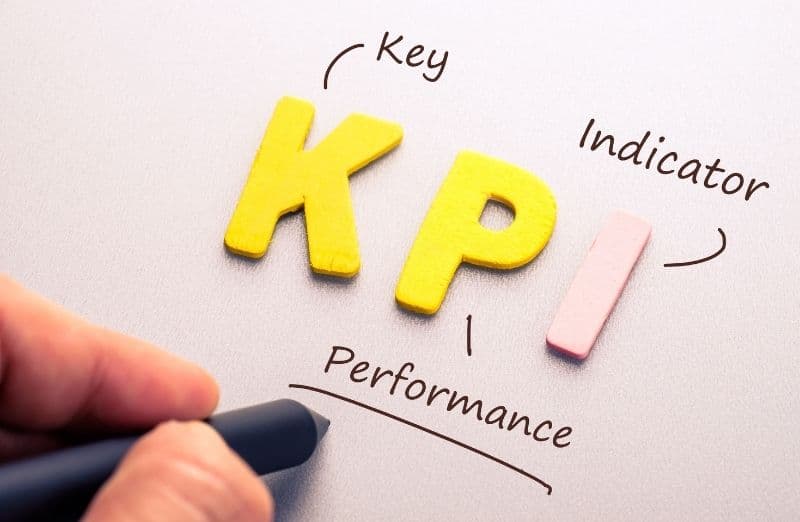How do you keep track of profitability, scalability, and revenue growth? What data dashboards do you look at to understand your success? If your team isn’t using KPIs, how do you plan to scale or grow your business in 2025?
KPIs stand for key performance indicators. These metrics provide an understanding of your sales process and unlock doors to opportunities in the future. From a sales perspective, these metrics look at your renewal rates, revenue growth, sales objectives, and prospecting initiatives. If you aren’t tracking these metrics regularly, you may never find ways to grow or scale your business.
KPIs are vital metrics your team should always have a pulse on. They provide invaluable insight into what you’re doing right and what you need to improve. Critical success factors play a crucial role in strategic planning by defining and measuring the progress of these KPIs. If you aren’t tracking KPIs regularly, you risk falling behind your competitors.

However, there are a few things you need to consider. While KPIs are important, not all will matter to your business. In fact, most businesses only need to track two to four KPIs consistently to see results.
We’re here to help you pick and choose KPIs that align with your industry and business dynamic.
Here’s what KPIs you should consider to guarantee sales success in 2025.
Understanding Key Performance Indicators (KPIs)
Key Performance Indicators (KPIs) are quantifiable measures used to evaluate the success of an organization in achieving its strategic objectives. These metrics provide a clear picture of an organization’s performance and progress towards its goals, enabling data-driven decision-making and strategic planning. A well-defined KPI should be specific, measurable, achievable, relevant, and time-bound (SMART), ensuring that it accurately reflects the organization’s objectives and priorities. By focusing on key performance indicators, businesses can track progress, identify areas for improvement, and make informed decisions that drive future success.
Types of KPIs
There are various types of KPIs, each serving a unique purpose in measuring different aspects of an organization’s performance:
- Strategic KPIs: These high-level measurements support a company’s long-term purpose, vision, and goals. They help in tracking progress towards strategic objectives and ensuring alignment with the company’s mission.
- Operational KPIs: These metrics measure the efficacy and efficiency of an organization’s daily operations, linking everyday activities with short-term goals. Operational KPIs are crucial for understanding how well the company is performing on a day-to-day basis.
- Leading KPIs: Indicators that predict future performance, such as website traffic or social media engagement. Leading KPIs provide early signals about potential outcomes, allowing organizations to make proactive adjustments.
- Lagging KPIs: Metrics that measure past performance, such as sales revenue or customer retention rate. Lagging KPIs offer a retrospective view of performance, helping organizations understand the results of their efforts.
- Balanced Scorecard KPIs: A framework that measures an organization’s performance from four different perspectives: Financial, Customer, Process, and People. This holistic approach ensures a balanced view of the organization’s health and progress.
By understanding and utilizing these different types of KPIs, organizations can develop a comprehensive performance measurement system that supports their strategic goals.
Importance of KPIs in Strategic Planning
KPIs play a pivotal role in strategic planning, as they:
- Align with strategic objectives: KPIs are designed to measure progress towards specific, measurable goals, ensuring that all efforts are focused on achieving the organization’s strategic objectives.
- Provide a clear picture of performance: KPIs offer a snapshot of an organization’s performance, enabling data-driven decision-making and helping leaders understand where they stand in relation to their goals.
- Enable data-driven decision-making: By providing insights into various aspects of performance, KPIs inform strategic decisions and drive business outcomes. This ensures that decisions are based on accurate and relevant data.
- Improve accountability and transparency: KPIs promote accountability and transparency, ensuring that all stakeholders are working towards common goals. This fosters a culture of continuous improvement and shared responsibility.
Incorporating KPIs into strategic planning helps organizations measure progress, identify areas for improvement, and make informed decisions that drive long-term success.
Leading and Lagging Indicators
Leading and lagging indicators are two types of KPIs that provide insights into an organization’s performance:
- Leading Indicators: These metrics predict future performance and provide early signals about potential outcomes. Examples include:
- Website traffic
- Social media engagement
- Customer satisfaction Leading indicators help organizations make proactive adjustments to improve future performance and achieve strategic objectives.
- Lagging Indicators: These metrics measure past performance and offer a retrospective view of results. Examples include:
- Sales revenue
- Customer retention rate
- Employee turnover rate Lagging indicators help organizations understand the results of their efforts and identify areas for improvement.
By understanding the difference between leading and lagging indicators, organizations can develop a comprehensive KPI framework that provides a balanced view of their performance and progress towards their strategic objectives. This balanced approach ensures that both predictive and retrospective insights are considered in decision-making processes, driving continuous improvement and future success.
10 Strategic KPIs You Should Track
When selecting the best KPIs for your company, it’s crucial to consider your business goals and objectives. Are you aiming to enhance your retention efforts, or is your focus on expanding your pipeline? Perhaps your goal is to increase revenue by 20% across the board for every sales representative.
After establishing your objectives for 2025, identify KPIs that align with both your top and bottom lines. This strategy allows you to refine your approach, concentrating on the KPIs most critical to your success.
Here are 10 strategic KPIs to consider for tracking performance in 2025, aimed at boosting sales team motivation:
Customer Lifetime Value

CLV= Average Purchase Value×Average Purchase Frequency×Average Customer Lifespan / Churn Rate
Customer lifetime value looks at the long-term value of your customers. With this KPI, you can predict how much revenue you’ll bring in. It will also provide insight into your customer lifespan and help you fine-tune your sales process to improve churn rates and customer retention initiatives. This is vital to the company’s success. An average increase of 5% in customer retention can help you increase profits by over 75%. Employee satisfaction is also a crucial KPI for enhancing organizational efficiency and talent retention.

Tracking this KPI can help you improve your retention sales and provide insight into what is and isn’t working with your current products and services.
Quote-to-Close Ratio
Quote-to-Close Ratio= ( # of Closed Deals / # of Quotes)× 100%
This KPI helps leadership better understand the effectiveness of their current sales process and tactics. You can use this KPI to see how successful your sales managers are at closing deals. If your quote-to-close ratio is longer than expected, you can use tools like gamification to help you adjust your overall approach to the sales process. Additionally, financial KPIs are crucial for assessing the fiscal health of the sales process and setting clear annual goals.
Sales Per Rep
Sales per Rep= Total Sales Generated by a Rep / # of Reps
Sales per rep focuses on the success of each sales rep for a given time period. Leadership can use this KPI to better understand the sales performance of each individual. You can use this KPI to set sales goals and benchmark your team’s performance for future time periods. When you check in on this KPI regularly, you can discover pain points and opportunities in real time and find innovative ways to improve your approach in the future. Aligning sales goals with strategic priorities can enhance overall performance.
Customer Acquisition Cost
CAC= Total Sales and Marketing Expenses / # of New Customers Acquired for the given time period
CAC looks at the average cost of acquiring a new customer. This KPI looks at the cost associated with your sales and marketing initiatives. With this KPI, you can optimize your sales process to be more cost-effective and efficient while finding new opportunities to grow and improve your sales process. KPI dashboards are crucial for visualizing and analyzing the cost-effectiveness of these sales and marketing initiatives.

If your CAC is too high, it can cut into your margins. To improve your profitability and scalability, you’ll want to take some time to fine-tune your sales strategy and find innovative ways to improve lead gen and conversion rates.
Monthly Calls or Emails Per Sales Rep
Monthly Total = Total # of calls or emails / # of sales reps
Never underestimate the power of prospecting calls or emails. If your team is always focused on renewals and revenue, they’ll forget how important connecting with your prospective audience is to your overall success. With this KPI, you can understand how productive and efficient your team is at taking on mundane workweek tasks.
If monthly calls and emails are lower than usual, you can use gamification to motivate your team during the workweek. Gamification uses game elements to keep your team engaged and motivated with mundane tasks. With a gamification strategy, you can increase productivity while keeping your team on track to reach their sales goals and targets.
Average Profit Margin and Financial KPIs
Average Profit Margin =(Total Profit / Total Revenue) x 100
This KPI measures the profitability of your company. Checking in on this KPI on a monthly or quarterly basis will help you gain a better understanding of your total revenue and help you better understand the total costs associated with the sales process. This is a great KPI to track if you’re considering increasing the prices of your products or looking for ways to boost profitability in 2025.
Monthly Sales Growth
Monthly Sales Growth= (Sales in Current Month – Sales in Previous Month / Sales in Previous Month) x 100

Monthly Sales Growth tracks your total sales revenue. With this KPI, you can discover seasonal trends and find new opportunities to capitalize on every quarter. It’s also a great KPI to track if you want to improve your monthly recurring revenue or renewal rates in 2025. Aligning sales growth with strategic priorities can enhance overall performance.
Number of Monthly Demos
# of Prospects x Current Conversion Rate / # of Sales Reps
If you sell software, subscriptions, or services, you know just how important demos are to the health of your sales pipeline. With this key performance indicator, you can track your team’s prospecting success and find ways to improve your approach to the sales process and effectively grow your file over time.
Customer Satisfaction and Churn Rates
Churn Rate = (Churn at the beginning of the month – churn at the end of the month / Churn at the beginning of the month) x 100%
Churn rates look at your retention initiatives. This KPI looks at how many customers canceled, paused, or didn’t renew their contract with your company. With a healthy churn rate, you can predict revenue for future months and put more focus on prospecting. Customer satisfaction may be low if your churn rates are high. This is something you’ll want to keep an eye on if it persists month over month.

The average churn rate sits around 3-5%, depending on your industry. As a company, this KPI is vital to the scalability of your business. If you’re constantly combating high churn rates, it can impact your total revenue and lead to flaws in the sales process. Additionally, employee satisfaction plays a crucial role in impacting customer retention and overall profitability.
Sales Target
Sales Growth = (Target Sales Goal – Current Sales / Divided by Current Sales) x 100%
This KPI may vary depending on the sales metrics you’re looking at. For example, if you’re trying to understand the success of each individual sales rep, you’ll take a look at their specific sales goals and assess their performance based on this metric. You may also have an overall goal for your team that you check to evaluate your overall sales process and your revenue growth. Financial KPIs are crucial in setting and achieving these sales targets, as they help measure key financial metrics such as revenue, profit margins, and overall profitability.

Supercharge Your KPIs With Gamification
Spinify is a sales gamification software to track KPIs and motivate your team during the workweek. Our platform integrates into your tech stack and uses your sales team’s personal data to help you develop innovative games, leaderboards, and progress bars. With our sales gamification tools, you can create personalized data dashboards using your KPIs. So you can track your success in real time. KPI dashboards are crucial for visualizing and analyzing the effectiveness of gamification strategies.




